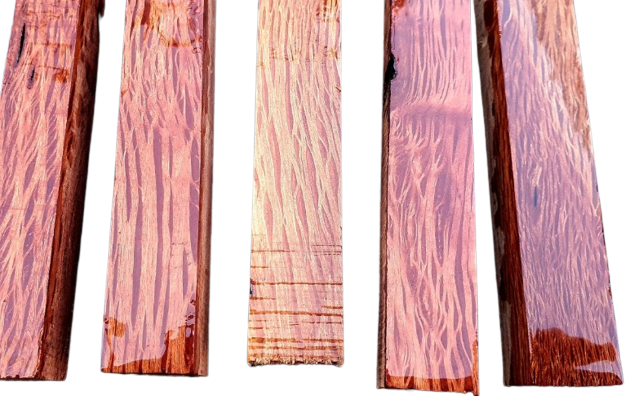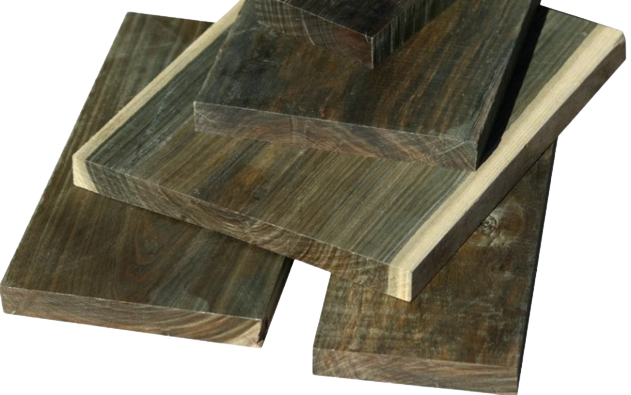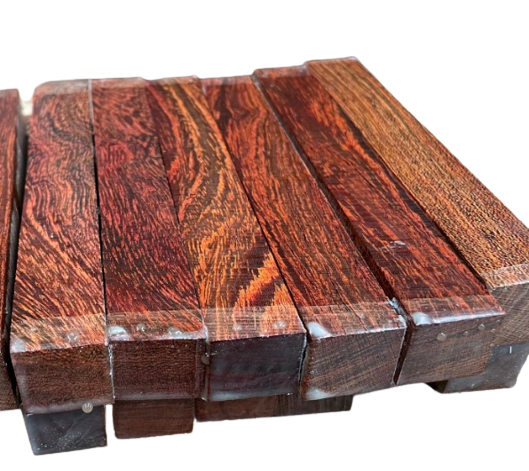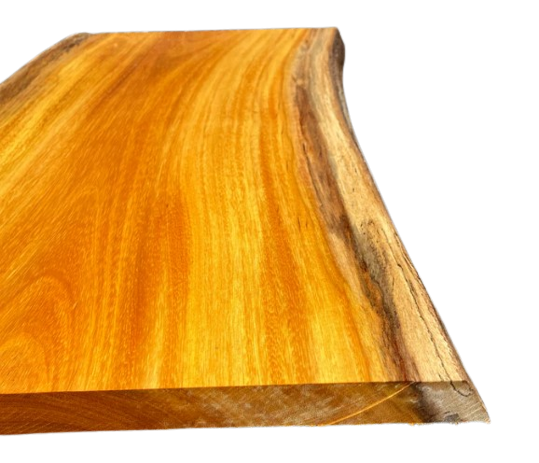When it comes to woodworking and construction, the choice of wood is critical. The Janka hardness test of a wood species can determine its suitability for various applications. In this comprehensive guide, we’ll explore the top 10 hardest woods in the world. These woods are renowned for their exceptional rigidness, making them ideal for a wide range of projects. Whether you’re a seasoned woodworker or a DIY enthusiast, understanding wood hardness can help you make informed decisions.
1. Australian Buloke (Allocasuarina Luehmannii)

Janka Hardness Rating: 5,060 lbf (22,500 N)
Australian Buloke, scientifically designated as Allocasuarina Luehmannii, stands out as a type of wood species that is prized for its extraordinary hardness, firmly establishing itself as one of the world’s hardest woods. This level of hardness means that Australian Buloke is incredibly dense and resistant to wear and damage. Due to its extreme durability, it is a preferred choice for applications that require strength and longevity.
Woodworkers often use Australian Buloke for crafting tool handles, construction timbers, and other demanding projects where durability is of utmost importance. Its robust nature and resistance to wear make it an excellent choice for applications that require tough and long-lasting wood.
2. Black Ironwood (Diospyros Rhodocalyx)

Janka Hardness Rating: 3,660 lbf (16,280 N)
Black Ironwood, scientifically known as Diospyros Rhodocalyx, is a wood species known for its remarkable toughness. It secures a high Janka Hardness Rating of 16,280 N on the Janka scale, which places it among the toughest woods in the world. This exceptional hardness makes Black Ironwood an ideal choice for various applications that require sturdy and resilient materials.
Woodworkers frequently use it for crafting high-end cabinetry, knife handles, and even musical instruments due to its ability to withstand wear and damage. Its durability and hardness make it a sought-after choice for projects where strength and longevity are crucial. Whether for functional or decorative purposes, Black Ironwood’s exceptional hardness ensures it can withstand the test of time in demanding applications.
3. Quebracho (Eysenhardtia Polystachya)

Janka Hardness Rating: 4,570 lbf (20,300 N)
The impressive hardness levels of Quebracho wood place it among the hardest woods in the world. Due to its extreme rigidness, it is a popular choice for various applications that demand resistance to wear and damage. Its intense red color and exceptional hardness make it ideal for uses such as heavy-duty flooring and high-quality furniture.
Whether for interior or exterior projects, Quebracho ensures it can withstand heavy use and continue to perform well in challenging conditions. Its robust nature and striking appearance make it a valuable material for demanding woodworking and construction projects.
4. Tatajuba (Astronium Fraxinifolium)

Janka Hardness Rating: 2200 lbf (9,800 N)
Tatajuba, scientifically known as Astronium Fraxinifolium, is a wood species notable for its substantial toughness and versatility. Native to South America, Tatajuba boasts natural resistance to decay and insects, making it an excellent choice for outdoor construction and decking projects where wood must endure challenging conditions, thanks to its impressive hardness.
Its resilience and durability ensure that it maintains its integrity and strength in outdoor environments, making it a valuable wood choice.
5. Genuine Lignum Vitae (Guaiacum Officinale)

Janka Hardness Rating: 4,500 lbf (20,000 N)
Genuine Lignum Vitae, scientifically known as Guaiacum Officinale, is a wood species recognized for its remarkable hardness, with a rating of (20,000 N). This exceptional hardness places it among the hardest woods globally and has earned it a reputation as one of the most durable and robust woods.
Genuine Lignum Vitae is often referred to as the “Wood of Life” due to its remarkable wear resistance and longevity. Its impressive hardness and natural lubricating properties make it a preferred choice for applications that require materials to withstand friction and wear, such as bearings, bushings, & mallet heads. Additionally, it is used in various marine applications, including ship propeller bearings, where its durability and resistance to seawater make it an ideal selection.
6. Bloodwood (Brosimum Rubescens)

Janka Hardness Rating: 2900 lbf (13,000 N)
Bloodwood, scientifically known as Brosimum Rubescens, is a hardwood species prized for its exceptional hardness and distinctive deep red color. It boasts a notable Janka Rating, which varies depending on the specific type of Bloodwood but can range from approximately 2,900 to 3,200 pounds of force (lbf). This impressive hardness makes Bloodwood an excellent choice for various woodworking and construction applications.
Bloodwood is frequently used for crafting fine furniture, flooring, cabinetry, and even musical instruments. Its striking red hue and robust nature make it an ideal material for decorative and functional projects. Additionally, Bloodwood’s natural resistance to decay and pests further enhances its suitability for outdoor applications, such as decking and outdoor furniture. The unique combination of hardness and vibrant color makes Bloodwood a sought-after wood species for projects that require both strength & aesthetics.
7. CAMELTHORN (Vachellia Erioloba)

Janka Hardness Rating: 3,680 Ibf (16,400 N)
Scientifically known as Vachellia Erioloba, Camelthorn is a hardwood species known for its impressive hardness, boasting a rating of 16,400 N in the Janka test, approximately equivalent to 16,370 newtons (N).
Native to southern Africa, Camelthorn is often the choice for applications where resistance to wear and damage is crucial. It excels in crafting fine furniture, flooring, and other high-quality woodworking projects due to its ability to endure heavy use. Its dense and robust nature ensures that it can withstand the test of time, making it an ideal choice for projects that require both strength and longevity. Camelthorn’s exceptional hardness and rich color make it a sought-after choice for various construction applications.
8. Osage Orange (Maclura Pomifera)

Janka Hardness Rating: 2,620 lbf (11,000 N)
Osage Orange, scientifically known as Maclura Pomifera, is a hardwood species hitting a notable Janka Rating of 2,520 pounds of force (lbf). While not among the absolute hardest woods in the world, it still offers a good degree of hardness and durability for various applications.
It is commonly used for crafting tool handles, bows, and even fence posts due to its ability to withstand substantial use. Its robust nature and appealing golden hue make it a suitable choice for woodworking and construction projects that require both durability and an attractive appearance. Osage Orange’s blend of hardness and versatility has made it a well-regarded choice in a range of applications.
9. African Teak (Afromosia)

Janka Hardness Rating: 1,570 lbf (7,000 N)
African Teak, also known as Afromosia, is a hardwood species with a Janka Hardness Rating of (7,000 N). While it may not be one of the toughest woods available, it still possesses a good degree of rigidity and durability, making it suitable for various uses.
Prized for its strength and resistance to wear and damage, African Teak is a popular choice for woodworking projects requiring robust materials. Crafters frequently use it to create high-quality furniture, cabinetry, and flooring due to its capacity to endure heavy use. The wood’s warm and attractive appearance also contributes to its desirability in decorative applications.
10. American Hophornbeam (Ostrya Virginiana)

Janka Hardness Rating: 1,860 lbf (8,300 N)
Scientifically known as Ostrya Virginiana, American Hophornbeam is a hardwood species recognized for its strength and resilience. The Janka Rating varies depending on the specific type, but it can range from approximately 1,510 to 1,860 pounds of force (lbf).
It is commonly used in crafting tool handles, wooden dowels, and even fine furniture. American Hophornbeam’s ability to combine hardness with versatility has made it a valuable wood selection for numerous woodworking and construction endeavors.
How to Choose the Hardest Wood for Your Woodworking Project?
When you’re seeking the hardest woods for your next endeavor, you have a remarkable array of options at your disposal. The Janka Hardness Ratings help us gauge the robustness of these woods, ensuring they can withstand the test of time and the rigors of your craftsmanship.
However, it’s important to remember that hardness is not the sole factor in wood selection. Each wood species offers its unique characteristics, aesthetics, and workability. Finding the right balance between hardness and other desirable qualities like grain patterns, color, and sustainability is the key to a successful woodworking project.
For more in-depth information on these remarkable woods and further information about their properties and applications, don’t hesitate to visit Timber Explore. It’s a valuable platform for timber and woodworking enthusiasts, providing comprehensive insights into the world of wood.

